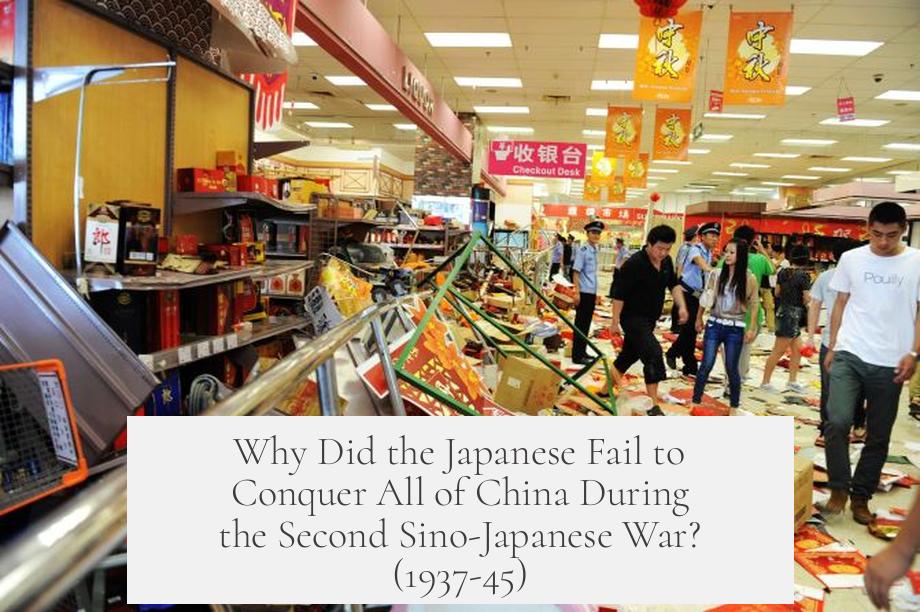The Japanese failed to conquer all of China during the Second Sino-Japanese War (1937-45) due to a complex combination of strategic miscalculations, resilient Chinese resistance, logistical challenges, political disunity within Japan, and increasing external support for China. Despite initial successes, the Japanese underestimated China’s ability to sustain a prolonged conflict and overextended their forces, which prevented them from achieving total conquest.
The war began with the Marco Polo Bridge Incident in July 1937. At that time, Japan’s initial goal wasn’t to conquer the whole of China but rather to secure key areas in northern China, like Beijing. The Japanese government viewed their early advances as sufficient and did not plan immediate full-scale war. However, the Chinese leader Chiang Kai-shek viewed continued Japanese expansion as intolerable. After Beijing fell, he chose Shanghai as a battleground, aiming to rally Chinese morale and international attention while defending a critical economic center.
Shanghai was strategically complex. The city was a major hub controlled partially by the Japanese Navy and partially by the Chinese Kuomintang government but with restrictions on troop deployment. The Japanese Army and Navy lacked full coordination, leading to conflicting operational objectives. While the Army wanted to consolidate control in northern China, the Navy insisted on holding Shanghai.
The Battle of Shanghai illustrates Chinese resilience and Japanese difficulties. While having superior firepower, Japanese marines initially struggled to suppress the Chinese defenders who sought to deny them port access. Chinese infantry lacked heavy weapons and coordination with armor, limiting breakthroughs. Japanese reinforcements arrived in late August but required months of intense combat to capture the city by October 1937 despite their tactical superiority.
Following Shanghai, the Japanese took Nanjing in November, but at great cost. Chinese forces suffered heavy losses, including elite units and China’s limited armor and air capabilities. The fall of these cities revealed a failed gamble by Chiang Kai-shek and demonstrated that Japan had not yet crushed Chinese resistance.
After these setbacks, Chiang switched to a strategy of trading space for time. Recognizing Japanese military advantages, he avoided direct confrontation when possible and sought to prolong the war, allowing China to rebuild its forces. The Japanese, overconfident in early predictions of a quick victory, failed to account for Chinese manpower outside Kuomintang control, especially guerrilla fighters and communists.
The Japanese military further strained its resources by advancing deep into China, stretching supply lines thin and leaving troops vulnerable. Chinese guerrilla operations effectively harassed overstretched Japanese forces, notably after battles like Xuzhou where many Chinese escaped encirclement. This guerrilla warfare exacerbated Japan’s logistical difficulties.
In April 1938, Chinese forces inflicted a rare defeat on the Japanese at the Battle of Taierzhuang. This victory shattered the myth of Japanese invincibility and boosted Chinese morale. Subsequently, Japanese offensives focused on targets like Wuhan, which fell in October 1938. Despite this, key Chinese assets, including the capital, were relocated inland to Chongqing, continuing resistance.
The Japanese air campaign against Chinese civilian populations, intended to force surrender, instead fueled resentment and strengthened Chinese resolve. Chinese counterattacks in places such as Suizhou, Changsha, and Guangxi disproved Japanese expectations of collapse after the fall of Wuhan. From 1939 to 1940, China’s prolonged counter-offensive caused heavy Japanese casualties and drained Japanese manpower, which Japan struggled to replace.
Japan’s political-military disunity compounded their problems. The Army, Navy, and government frequently operated with conflicting objectives and poor coordination, limiting the effectiveness of their campaigns. Meanwhile, China’s internal unity improved under the threat of invasion, with both Kuomintang and Communist forces resisting Japanese advances.
The definitive turning point was the entry of the United States into the war after Japan’s attack on Pearl Harbor in 1941. Allied aid increased significantly, enhancing Chinese military capabilities and morale. Following this, Japan could no longer gain ground and steadily lost territory in China until surrender in 1945.
| Key Factors for Japanese Failure to Conquer All China |
|---|
| Initial limited Japanese war aims not focused on total conquest |
| Strong Chinese leadership with strategic shifts (trading space for time) |
| Guerrilla warfare and sustained resistance beyond conventional forces |
| Japanese political-military disunity between Army, Navy, and government |
| Logistical overextension and vulnerable supply lines for Japanese forces |
| Chinese victories like the Battle of Taierzhuang undermining Japanese momentum |
| International support for China intensifying post-1941, notably from the US |
- The Japanese aimed to secure key regions, not full conquest initially.
- Chinese leadership effectively shifted to a war of attrition and defense in depth.
- Japanese forces struggled with coordination and overextended supply lines.
- Guerrilla tactics and Chinese counteroffensives depleted Japanese resources.
- Allied intervention after 1941 strengthened Chinese resistance.
Why Did the Japanese Fail to Conquer All of China During the Second Sino-Japanese War? (1937-45)

Simply put, the Japanese never intended to conquer all of China outright, and complex political, military, and logistical hurdles turned their initial swift gains into a grueling, multi-year stalemate. Let’s delve deeper into the tangled story behind Japan’s failure to fully subjugate China during the epic eight-year conflict.
At first blush, the Japanese invasion of China looks like a textbook case of rapid conquest. After the Marco Polo Bridge Incident on July 7, 1937, Japanese forces rolled quickly into Northern China, grabbing cities including Beijing. But the Japanese government didn’t dream of grabbing China in one fell swoop. They were content with limited territorial gains and hoped to avoid a prolonged war. The sudden escalation was more an accident of ambition than a grand strategic plan.
Meanwhile, on the Chinese side, the Kuomintang (KMT) led by Chiang Kai-shek was cautiously preparing for the inevitable showdown. Chiang’s aim was clear: build the military and the industrial backbone to meet Japan on equal footing. His game was patience. But after Beijing fell, the Chinese mood shifted dramatically. Chiang sensed the nation’s tolerance had snapped. After enough provocations, it was time to take a stand, starting with a colossal battle in the vital port city of Shanghai.
Shanghai was no random choice. It was a gamble. You see, Chiang’s wisdom or stubbornness here remains debatable. Shanghai was China’s industrial heart, bustling with resources that Chiang had painstakingly nurtured. Losing it would deal a body blow. But Shanghai also posed strategic advantages. The complex river network of Jiangsu province helped level the battlefield, blunting the Japanese advantage in tanks and armor. Plus, Shanghai’s significant expatriate population meant the world’s eyes were on that city. Chiang hoped global attention might pressure Japan or boost Chinese morale.
Yet, Shanghai’s control was a tightrope act. A treaty from 1932 left the Chinese with nominal control but very restricted military presence—only a small police force was allowed. The Japanese maintained a garrison of over 6,000 marines inside the city. Technically, both sides were coexisting in a tenuous and tense truce territory.
Add to this the muddled nature of Imperial Japan’s own command structure. The Japanese Army, Navy, and central government frequently operated like siblings fighting over the TV remote. The Army wanted to consolidate gains in northern China and avoid opening another costly front. The Navy insisted on holding on to Shanghai no matter what. These internal frictions paused the momentum and complicated Japanese strategy.
What happened next sounds like a David and Goliath story, but with tanks and machine guns. Chinese forces attacked the Japanese marine garrison in Shanghai aiming to deny them the port facilities crucial for reinforcements. The heavily outnumbered Japanese firmly dug in, buttressed by naval bombardments and aerial strikes. Chinese infantry lacked heavy weapons and struggled to break through fortified Japanese positions. Their tanks were outmatched due to poor infantry-armor coordination and Japanese anti-tank defenses.
On August 23, the tide started to turn against the Chinese. Japan sent in powerful reinforcements. Although facing a near 2:1 numerical disadvantage (700,000 Chinese troops versus 300,000 Japanese), Japanese weapon superiority and combined arms support within months wore the Chinese down. The Battle of Shanghai dragged on until late October when Chinese forces finally began retreating. This battle alone was a brutal, costly slog that drained China’s elite troops, tanks, and air power—one of Chiang’s most painful gambles.
Then came the fall of Nanjing, the capital before the war. Chinese troops, exhausted after months of fighting at Shanghai, were ordered to retreat to defensive lines around Nanjing. But here, sheer chaos and betrayal surfaced: Chinese civilian officials fled, abandoning their posts and locks on the defensive fortifications. By November, Nanjing fell into Japanese hands, marking a crushing defeat. Chiang’s gamble to trade territory for time had failed miserably—his best divisions destroyed, key cities lost.
So what now? How did China keep fighting when so much was lost? Enter the brilliant, if desperate, strategy of trading space for time. Chiang knew Japan’s military might was overwhelming, so he ordered a strategic withdrawal into the vast interior. This wasn’t surrender—it was survival. The idea: stretch Japanese supply lines thin, cultivate local resistance, and rebuild strength.
The Japanese, flush with victory at Nanjing, fell victim to hubris. They expected the war to end in three months. But they underestimated China’s complex reality. The KMT wasn’t the entire Chinese military picture. The Communists controlled regions outside KMT’s control, and shattered units gradually reassembled. An endless stream of recruits fueled continued resistance.
Another kink in Japan’s armor was its overextended supply lines. Marching deep inland meant Japanese forces were distant from ports and vulnerable. The Battle of Xuzhou showcased this perfectly. The Japanese encircled Chinese troops but failed to capture them outright. Many Chinese escaped to wage guerrilla warfare—a nightmare for any occupier. Despite air supply drops, Japanese troops were stranded, undersupplied, and vulnerable.
The Battle of Taierzhuang in April 1938 shattered a myth that Japanese forces were invincible. Even with fewer conventional weapons, Chinese troops routed a Japanese advance. This was a morale game-changer for China. Suddenly, hope flickered in what had felt like a relentless catastrophe.
Afterward, the Japanese revised their strategy. Instead of chasing elusive Chinese forces into vast, rugged interiors, they stuck close to maritime supply routes and moved west along the Yellow River to seize Wuhan. Wuhan fell in October 1938 after stiff Chinese resistance. Again, Japan secured a major prize but failed to break Chinese will.
When Japan demanded negotiations, Chiang refused unless the Japanese withdrew to pre-1937 borders—a non-starter for Tokyo. Chiang moved the Chinese capital to Chongqing, further inland, beyond easy Japanese reach. This refusal to capitulate was remarkable. It forced Japan into brutal aerial bombings of civilian areas—an unforgivable tactic meant to break Chinese morale but only deepened hatred and resistance across the country.
Then came surprise. After Wuhan, Japan anticipated a quick Chinese collapse. Instead, Chinese counterattacks at places like Suizhou, Changsha, and Guangxi stunned the invaders and inflicted heavy casualties. Between 1939 and 1940, China mounted a sustained counter-offensive. Though ultimately unsuccessful in retaking territory, it chipped away at Japanese strength, causing 60,000 to 70,000 casualties—a heavy toll for an occupying force.
Finally, the global tide turned with Pearl Harbor in 1941. Japan’s attack on the United States brought America—plus the Allied powers—fully into the war. China, as an Allied member, gained much-needed military aid and diplomatic support. From that point, Japan was on the defensive, gradually losing ground until surrender in 1945.
A Summary Table of Key Reasons Japan Failed in China
| Reason | Explanation | Example/Event |
|---|---|---|
| Initial Intentions | Japan did not plan total conquest; limited gains were acceptable | Post-Marco Polo Bridge Incident restraint |
| Chinese Resistance | Chinese war strategy traded space for time | Battle of Shanghai, guerrilla warfare after Xuzhou |
| Japanese Internal Divisions | Army, Navy, Government often disagreed on China strategy | Disputes over Shanghai garrison |
| Overextension of Supply Lines | Japanese forces strained far from ports, vulnerable | Battle of Xuzhou failures |
| Chinese Morale and International Attention | Chinese defiance & global focus helped sustain resistance | Shanghai expat awareness and Chongqing capital relocation |
| Allied Involvement | U.S. and Allies’ entry bolstered Chinese war effort | Pearl Harbor, 1941 |
So, was Japan’s failure a matter of Chinese grit, Japanese missteps, or global politics? The answer: yes, all of the above, wrapped in a long and bloody conflict. Japan underestimated China’s immense territory, population, and will. Internal Japanese miscoordination stalled decisive actions. Chinese leadership tolerated heavy losses but refused surrender, trading terrain for time. Local guerrilla actions sapped Japanese strength, while Allied entry sealed Japan’s fate.
Can you imagine if Japan had pushed harder for total conquest early on? Or if Chiang Kai-shek hadn’t gambled on Shanghai’s defense? History might read differently. Instead, the Second Sino-Japanese War became a grinding war of attrition. It stunned Japan’s supposed invincibility and added crucial years to China’s fight for survival.
For students of military history, it’s a classic example of how large countries with determined populations can resist aggressive but logistically strained invaders. It also shows the limits of technological and tactical superiority when strategy, geography, and politics favor the defender. Finally, it’s a stark reminder that war’s outcomes hinge as much on leadership decisions and morale—as on tanks and planes.
So next time you ponder why Japan failed to conquer all of China, remember this rich tapestry of battles, strategies, and stubborn willpower that combined to keep a sprawling nation from total defeat—even when the odds seemed stacked against it.
Why didn’t Japan aim to conquer all of China from the start?
Japan initially focused on limited territorial gains after the Marco Polo Bridge Incident. The government was satisfied with controlling parts of northern China. They did not plan for an all-out conquest of China at first.
How did Chinese strategies limit Japanese progress in Shanghai?
Chinese forces tried to deny Japanese use of key ports to stop reinforcements. Though outnumbered, defenders used bunkers and terrain advantages. Poor coordination of Chinese tanks and infantry reduced their effectiveness against Japanese positions.
What internal issues in Japan affected their war effort in China?
Japan’s Army, Navy, and government often acted independently. The Army wanted to focus on northern China, while the Navy insisted on holding Shanghai. This disunity hindered a united and effective Japanese campaign.
Why was the Battle of Shanghai significant in prolonging the war?
The battle lasted months despite Japanese superiority. Chinese troops numbered over twice the Japanese forces. Stubborn defense and urban complexity made it costly and slow for Japan to capture the city, delaying further advances.
What factors caused Chiang Kai-shek’s strategy to fail in defending China?
Chiang aimed to use Shanghai to halt Japan and gain international support. However, heavy losses, failure to hold defensive lines at Nanjing, and exhausted troops weakened Chinese resistance. Key cities eventually fell, and losses hurt China’s war effort.




